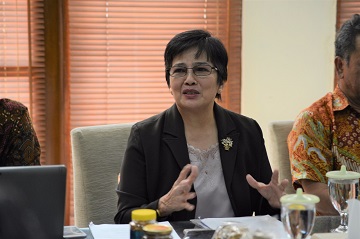Professor of IPB: An Integrated Husbandry Increase Profit Up to 100 Percent

Professor of the Faculty of Animal Husbandry Bogor Agricultural University (Fapet-IPB), Prof. Dr. Asnath Maria Fuah said that the use of land, crops and livestock-based integration can increase profits by 10-100 percent compared with no integration. This was conveyed during the Pre-Press Conference of Scientific Oration at IPB Baranangsiang Campus (19/7).
An example is the integration of potential animals (Satwa harapan) in urban areas or urban farm livestock. The system of coffee-honey bee integration (sinkolema) can increase honey production reaches 114 percent. This result is higher than the production of honey from bees maintained outside the integration area. The production of coffee beans increased by 10.55% ie from 118 tons / ha to 131 tons / ha.
"In addition to coffee and bees, insect cultivation can also use the pattern of integration. For example, the business of cricket farms with a land area of ??64 square meters can provide net profit of 27 million rupiah per year. In addition, cultivation of Hongkong caterpillars with the same land area can generate net profits of 28 million Rupiah per year, "he explained.
Meanwhile, based on the land use aspect, the integration areas for cattle, buffalo, goat and sheep are spread over four zones and consist of 19 grazing areas, 46 plantation areas, 38 densely populated agricultural areas and 1 million hectares of forest buffer area.
"The government is targeting 12.7 million hectares of forest buffer area. The goal is to increase the income of the people who live in the area around the forest. Of course, there are potential and constraints, "she said.
According to her, the integration of cow-palm oil in Sumatra and Kalimantan has positive impact on farmers-farmers increase by 40-60 percent. Integration of cattle with rice, maize and soybean (pajale) on tidal land shows that the utilization of cow manure and bio-slurry compost increases soybean productivity by 62 percent. Farmer income increased by 30-45 percent with R / C ratio of 1.83.
On the other hand, the application of system integration also has constraints. Based on the scale of business, small-scale enterprises must face several problems include limited land, labor and capital. While in the group effort, there are constraints such on the organizational management capability and the use of technology especially the results management and waste management. And on the scale of the region, there are limited capital, access to infrastructure, inter-agency coordination and distribution and supply chain products have not been efficient.
"The synergy of cross-sector programs is not yet underway, organizational commitment and implementation of integration policy between related institutions have not been effective," she explained.
Therefore, she provides several recommendations that can be applied that is an effective partnership with the active role and strong commitment of multi-stakeholder; meat self-sufficiency needs to be supported by other livestock commodities (sheep, goats, poultry and various cattle); as well as policy support from government and related institutions concerning spatial regulations and the establishment of livestock integration areas.
"Multi-stakeholder are means institutions of higher education, private, government, community and media. Adopting model ABGC-M or pentahelix, "she said (DMR).


